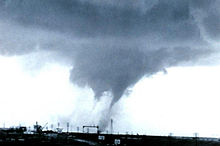Climate of Dallas
Vibrant wildflowers (such as the bluebonnet, Indian paintbrush and other flora) bloom in spring and are planted around the highways throughout Texas.
The weather in Dallas is also generally pleasant between late October and early December, and unlike springtime, major storms rarely form in the area.
In the spring, cool fronts moving south from Canada collide with warm, humid air streaming in from the Gulf Coast.
Based on 1991-2020 climate data, the average coldest temperature for an entire year is about 19.1 °F (−7.2 °C), placing Dallas in USDA zone 8b.
The construction forces of the Texas & Pacific worked feverishly to safeguard the long trestle carrying their tracks across the stream.
Suddenly this whole structure turned on its side down-stream, broke loose from the rest of the track at one end and swung out into the middle of the current and began breaking up, first into large sections and then into smaller pieces, rushing madly along to some uncertain destination.
[Approximately half a dozen of the workmen fell into the torrent at this point; exaggerated reports of their drowning swept the city.
Much to the horror of residents, thousands of livestock drowned in the flood and some became lodged in the tops of trees—the stench of their decay hung over the city as the water subsided.
[19] After the disastrous flood, the city wanted to find a way to control the reckless Trinity and to build a bridge linking Oak Cliff and Dallas.
[19] In May 2015, the Dallas-Fort Worth Airport received a record-shattering 16.96 inches of rainfall, in a month that obliterated heavy-rainfall records virtually throughout the Southern Plains (Texas and Oklahoma, especially).
During the warm phase (El Niño), winter and spring are colder and receive more snow than usual.


